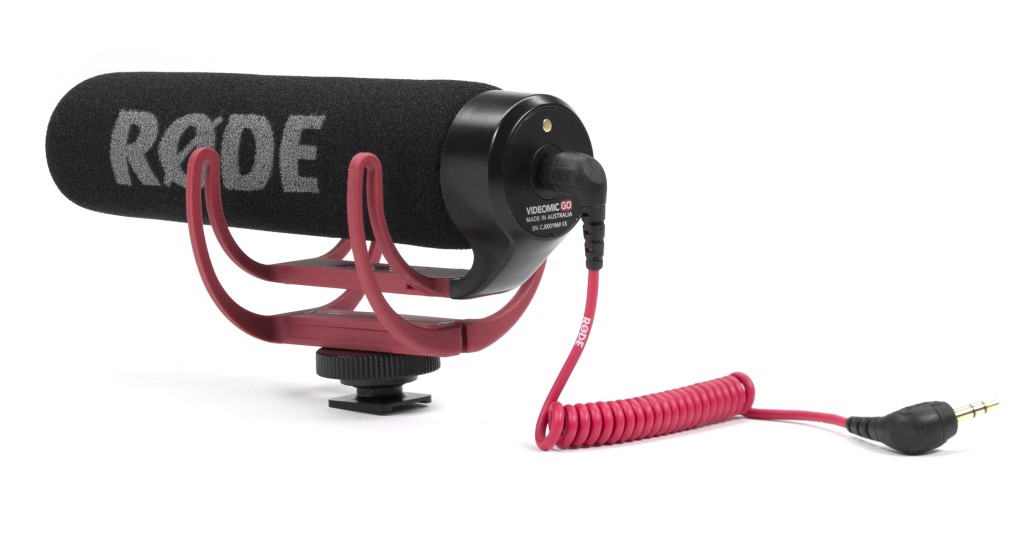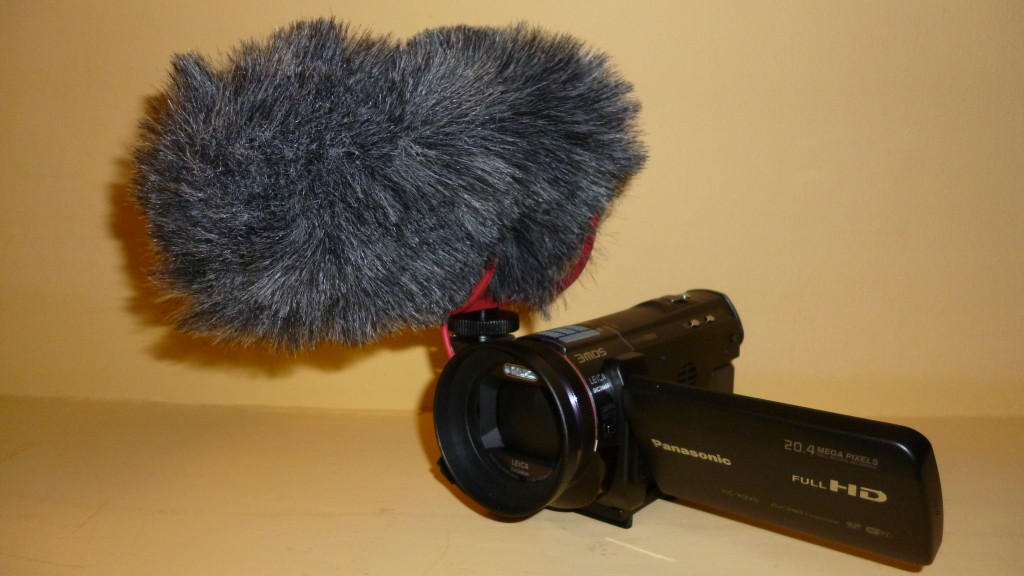Review: Rode VideoMic GO
Ask any group of DSLR video shooters what external microphone they have plugged into their cold shoe and one name is certain to crop up consistently: the Rode VideoMic.
There are others of course, from the likes of Sennheiser, Que Audio, and Shure, but Rode have cleverly managed to make their name the defacto standard in better onboard audio both for the aforementioned DSLRs and for consumer camcorders.
The VideoMic products are light weight, relatively low cost, and have good quality audio but Rode clearly thinks there’s still a gap in the market as they’ve just launched their VideoMic GO, an even lower-cost (around £65 GBP) and easier to use entrant into the field.

The GO is so named because you just plug it in and start filming. It has no controls or adjustments on it whatsoever. There’s no need to worry about how many dB of gain or cut you want and whether you should switch on a low pass filter because it doesn’t offer any such adjustments. There’s the microphone, a shockmount, and a dual-mono lead – because the microphone is mono – to connect to your camcorder or DSLR.
Take care though, because although the GO doesn’t need a battery to work, it does need so-called “plug-in power”. This is a low voltage signal provided by the camcorder or DSLR through its microphone socket. This mic therefore won’t work with some Canon camcorders and some early DSLRs because they don’t provide plug in power. For example, we tested it on an XA20 camcorder and it doesn’t work. The HF-G25 (G20) also doesn’t provide plug in power.
That caveat aside however, the mic is very straightforward to use. Just slide it into your camcorder’s cold shoe, plug one end of the 3.5mm lead into the mic and the other end into your camcorder, and off you go.
It weighs a featherlight 73 grams and as such you will barely notice it other than by virtue of it giving your camera a more “pro” look, which is always a good thing we feel. A foam windshield is included but for outdoor shooting you will still need to invest in a proper fluffy windjammer such as Rode’s own “Deadcat” or the Rycote Mini Windjammer (no foam shield on earth will ever combat outdoor wind noise sufficiently). The shockmount gets in the way a bit since it surrounds the back end of the mic but it’s not impossible to fit the windjammer as you can see from our photo:

Sans foam, the mic is 150mm long; with it it’s 165mm. From the centre of the cold shoe to the tip of the foam is a shade under 110mm, so you can use that figure to work out if the mic will stick out too far in front of your camera’s lens so as to stray into shot when the zoom is wide.
We are reluctant to bash the shockmount around too much so any queries about its durability under real-world use will have to wait a few weeks until we’ve actually given it a fair workout. But it’s very springy so should bounce off any average knocks and bumps.
So, let’s turn to sound quality since that, after all, is what the mic is all about. For starters, the VideoMic GO will inherently do a much better job of capturing ambient sound than any inbuilt mic. On board mics are not only poorly positioned but are liable to capture any handling noise from your fingers on the camcorder’s body while you film. Sticking a mic on a shockmount and pointing it towards your subject will always bring a dramatic improvement and indeed in this case it does.

Rode also claim it’s suitable for dialogue and we sort of agree but with reservations. Sure, it’ll beat an onboard mic but mics really only work well for the spoken word if the subject is no more than a couple of feet away and you’re unlike to film anyone that close unless you’re vlogging. So you’ll still be much better off micing a presenter or interviewee with a tieclip microphone or a shotgun held up close rather than on-camera.
That said, our vocal tests showed a perfectly pleasant recording sound that’s not too thin and reedy like some competing mini shotguns we can think of.
The VideoMic GO tech specs include a signal-to-noise ratio of 60dB, a dynamic range of 96dB and a max handling level of 120dB. This is, you’ll note, an unbalanced microphone so it’s much less tolerant of electrical noise than more expensive balanced ones. We held it near a fluorescent energy-saving lightbulb and picked up a nasty 50Hz buzz. Going too near to a cordless telephone was worse with a pronounced buzzing which varied according to proximity and the angle of the mic with respect to the handset.
Don’t let’s panic about this though – we had to put the mic pretty much next to those other gadgets in order to prompt the interference and as soon as we moved away it disappeared. But it is certainly a factor to bear in mind when you’re filming and a cautionary tale that you must wear headphones when recording (and listen to what they’re telling you)
Overall then we like the VideoMic GO. It’s very low cost, light weight, couldn’t be any easier to use and sounds quite pleasing. We’d caution prospective purchasers that they need to ensure their intended video camera can provide the requisite power for the mic, and we’d reiterate the point about headphone monitoring. But in conclusion, we think Rode have another winner on their hands.
Would you like to buy the VMGo? Please do so via our Amazon link and we get a small commission which pays our web hosting fees: http://amzn.to/1pZ2VEk
Here’s our full test video:
More info from Rode themselves at www.rodemic.com/mics/videomicgo
Thanks for the nice review.
I was alarmed by the specifications’ 34dBA equivalent noise figure, but it is much better than the built-in mic.
It would be interesting to compare the interference from lightbulbs, DECT and WiFi on a variety of mics.
I don’t suppose you have any insider info on the “VideoMic HD” with integrated recorder ?
It seems to have been quietly shelved – perhaps no-one signed up to express an interest last year …
Hi; thanks for the comment and apologies for the late reply. The figures aren’t great, true, but it’s a very low cost mic and it’s still much better (as you point out) than the internal mic. I will enquire of Rode about the HD version and report back…
Hi again. I asked Rode about the VideoMic HD and they said: “We have made a decision to invest resources into other projects that we think are more viable. It’s definitely not killed off, but development has been frozen for the time being. We’ve got some exciting products set for release in the first half of next year that we feel will find better market acceptance.”
I’m trying to use the Rode VideoMic Go with a Canon hf r400 camcorder but it won’t pick up any sound. Will it. It work with this camera?
Hi. None of the Canon camcorders I’ve ever used have supplied any power to the mic socket (“plug in power”) which the Rode Videomic Go requires.
So although I have not tried the HF-R400 specifically, I would imagine that the Videomic will not function with it. Sorry!
is it compatible with black magic pocket? thanks
No; the BlackMagic camera does not provide any “plug in power” on the mic socket so mics like the VideoMic GO which have no internal power and need some from the camera, won’t work.
Is the mic compatible with Sony’s CX 550 handycam? Can’t find any specs on that camera if has ‘plug in power’.
Hi. Sony’s manual for the CX550 lists the mic socket as “MIC (PLUG IN POWER) jack” from which I would surmise that the camcorder probably does provide the required voltage and therefore the Videomic GO should work… touch wood!
The tightening ring seems to be frozen as I can not turn it either clockwise or counter clockwise. Any ideas?
I can only suggest it’s broken.